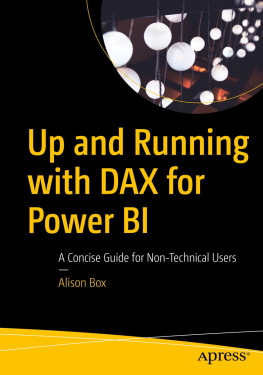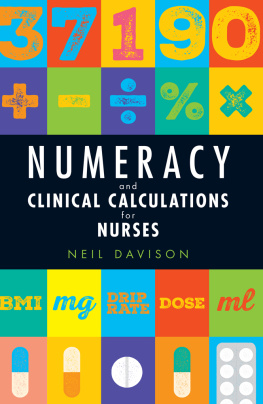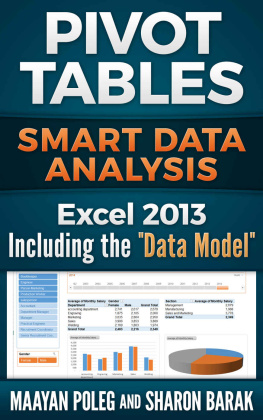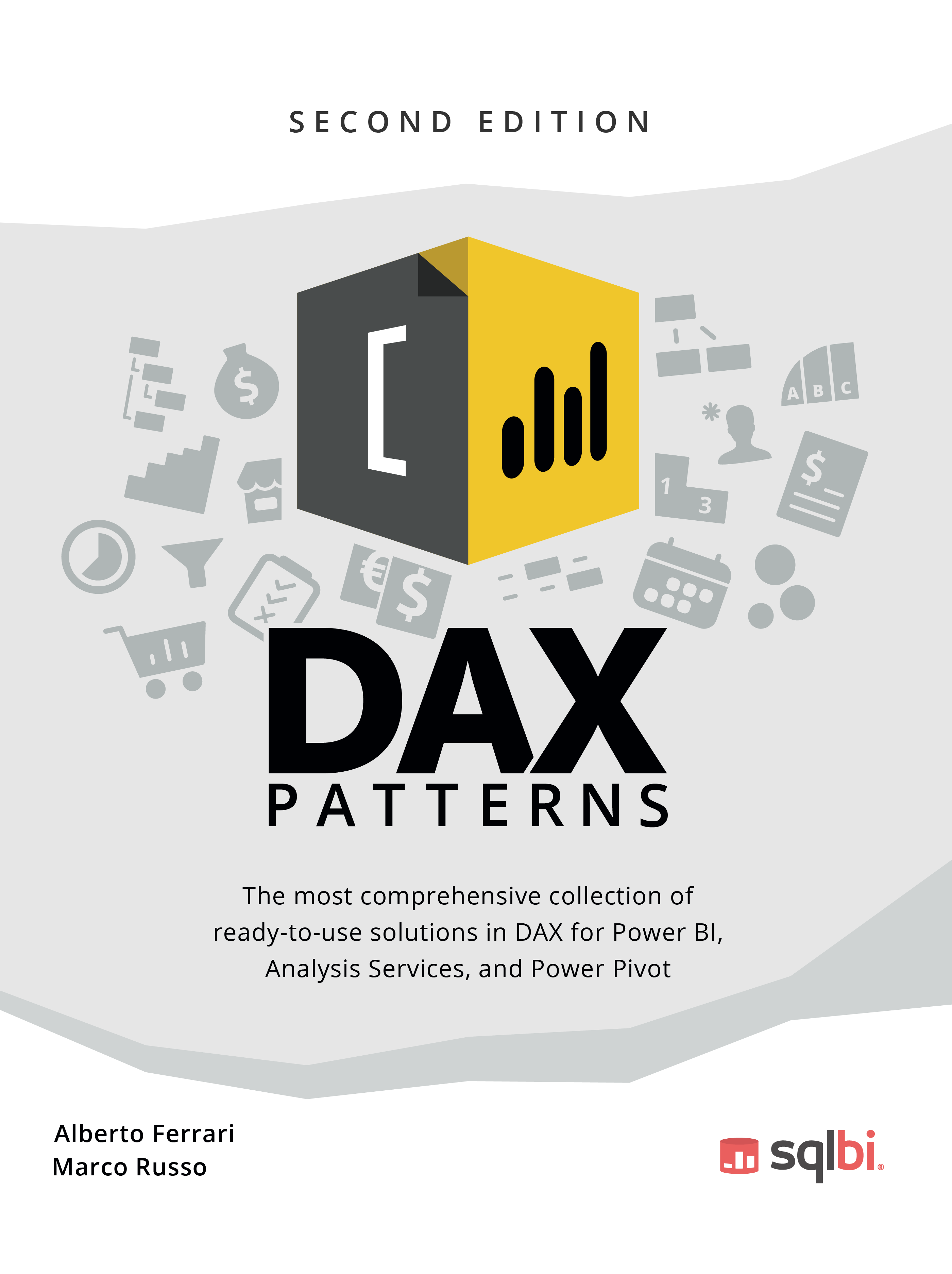DAX Patterns
SECOND EDITION
The most comprehensive collection of
ready-to-use solutions in DAX for Power BI,
Analysis Services, and Power Pivot.
Alberto Ferrari
Marco Russo
Copyright 2020 by Alberto Ferrari and Marco Russo
All rights reserved. This publication is protected by copyright, and permission must be obtained from the publisher prior to any prohibited reproduction, storage in a retrieval system, or transmission in any form or by any means, electronic, mechanical, photocopying, recording, or likewise. Microsoft and the trademarks listed at www.microsoft.com/en-us/legal/intellectualproperty/trademarks/usage/general are trademarks of the Microsoft group of companies. All other marks are property of their respective owners.
The example companies, organizations, products, domain names, email addresses, logos, people, places, and events depicted herein are fictitious. No association with any real company, organization, product, domain name, email address, logo, person, place, or event is intended or should be inferred.
This book expresses the authors views and opinions. The information contained in this book is provided without any express, statutory, or implied warranties. Neither the authors, the publisher, nor its resellers, or distributors will be held liable for any damages caused or alleged to be caused either directly or indirectly by this book.
Publisher / Editorial Production: SQLBI Corp., Las Vegas, NV, United States
Authors: Alberto Ferrari, Marco Russo
Copy Editor: Claire Costa
Technical Editors: Daniil Maslyuk, Sergio Murru
Cover Designer: Daniele Perilli
ISBN: 978-1-7353652-0-6
Library of Congress Control Number : 2020912594
All the samples and files used in this book are available on www.daxpatterns.com
All the code in this book has been formatted with www.daxformatter.com
Introduction
At SQLBI we have a beautiful job: we are world-wide trainers and consultants. We meet thousands of people all over the world every year: a crowd of very diverse persons, sharing the same passion for Business Intelligence and DAX. We are asked to solve scenarios of various complexity by our students and customers.
Say a student approaches you because they need to compute the number of new customers for their report. You solve the problem once, twice, three times And at some point, you feel that the next time you need to answer the same question, you would love to have a ready-to-use solution. This is the reason we started the daxpatterns.com website in 2013. We started collecting patterns that repeat themselves. We created a collection of DAX formulas aimed at solving the most frequently-asked questions we receive. At that time, the goal was not to write a new book. Instead, our goal was to create some sort of memory bank for the solutions we would find. We thought we would be the main users of our own website.
As is often the case, real-life does not go according to plan. This time, for the better. The website had a tremendous success. Users downloaded the samples and achieved two different goals: they found a ready-to-use solution to their problems, and they improved their DAX skills based on the formulas we authored. Because of the different file formats, we included samples for Excel 2010 and Excel 2013 the latter still works with later versions of Excel. Eventually, we collected the content of the website into a book. That was the first edition of DAX Patterns. It was at the end of 2015. At the time, we had not yet published the first edition of The Definitive Guide to DAX. Therefore, we included a short introduction to DAX in the DAX Patterns book.
Many things changed over the following five years. DAX evolved with many useful features. Most importantly, Power BI hit the market and the number of users adopting DAX grew at an exponential rate. Today, most of the DAX users create a Power BI solution. When we published the first edition of this book, Power BI had not even been announced yet.
During these five years, the process of collecting patterns continued. We met more students, we solved more problems, we also got better and better at DAX. Plus, we now had thousands of users who were able to provide feedback on previous patterns. Studying user comments gave us a better picture of what our readers needed. In parallel, we went on to publish two editions of The Definitive Guide to DAX. At that point, there was no longer a reason to be teaching DAX in a book about patterns.
Long story short, it started to make a lot of sense to author a new version of both the DAX Patterns website and book. We rolled up our sleeves and created the book you are reading right now.
We did not use any of the content from the previous book. We wanted a fresh start. The entire library of code is rewritten from scratch, using the latest DAX and Power BI features and adapting the code to Excel 2019 when necessary.
In this new edition we made several choices:
- We greatly increased the share of the book dedicated to time intelligence calculations. Time intelligence is by far the most widely studied topic. Therefore, it made sense to increase the number of time-related calculations and patterns.
- Similarly, the New and returning customers pattern was an absolute hit. We gave that pattern a bigger share of the book as well, increasing the number of formulas and models to compute new and returning customers.
- We increased the number of patterns, adding several that in our experience are likely to be useful to our readers.
- We decided to cut out a few patterns. For example, the chapter about statistical calculations was useful back in 2015, because of the lack of statistical functions in DAX. Since then, DAX introduced many new functions to compute the formulas that were explained in that chapter. There is no need for that content in 2020.
- We no longer provide code snippets. In the previous book, most of the code was shown including placeholders for the columns that readers were likely to change. We no longer do that. We show code that works, because you often have to adapt the data model and other details in the formula. We felt this would make the code more readable and easier to use and to adapt to your model.
- We optimized every single formula. All the code you see in these patterns has been thoroughly reviewed for performance. This is not to say that these patterns are the very best. They are the best we could come up with. If you can make the code better and faster, let us know! The comment sections on the website are the right place to provide your feedback.
- We created a Power BI and an Excel version of each sample file. In the book, we include pictures of Power BI reports showing the results of the code, but the examples you can download are available in both formats: Power BI and Excel.
- We improved the readability of the eBook version of DAX Patterns. This meant keeping the code formatting intact regardless of the eBook reader size.
Why we published this book
If you are wondering what the differences may be between the content of this book and the content published on daxpatterns.com, we want to assure you that there are no differences. Should you buy the book to obtain extra content? No. The access to the web site is free, where you can read the same content as what you will find in this book and download the sample files for free.














